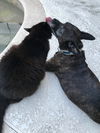Welcome to Pet Rescue By Judy!
401 South Laurel Avenue
Sanford, FL 32771
(407) 302-4497
info@petrescuebyjudy.com
Chayanne the Manchester Terrier's Web Page

| My Rescue |
| Login to Remember your Favorite Animals and Breeds! |
Chayanne the Manchester Terrier needs a caretaker or foster!
Won't you consider helping her get a new start?
Won't you consider helping her get a new start?
Name: Chayanne the Manchester Terrier
Adoption Fee: $200
Species: Dog
Breed: Manchester Terrier / Basenji (short coat)
Learn more about the Manchester Terrier.Learn more about the Basenji.
Color: Brindle
Pattern: Brindle
Sex: Female (spayed)
Current Size: 33 Pounds
Potential Size: 35 Pounds
General Potential Size: Medium
Current Age: 15 Years 7 Months (best estimate)
Activity Level: Moderately Active
Indoor or Outdoor: Indoor Only
Housetrained: Yes
Microchipped: Yes
Description:
Chayanne was adopted from us in March of 2010. Recently she showed up at Animal Control. We called the adoptive family only to learn they had "gotten rid" of her months earlier and do not want her. Chayanne is back with us and looking for her real forever home.
2010: Chayanne was found as a stray and brought to us so we don't know a lot about her. The family who found her looked for her owners, but none came forward. As they lived in a non-pet friendly complex, they were forced to bring CHAYANNE to us before their landlord kicked them out for trying to help a homeless puppy, nice, huh? We do know that CHAYANNE is good with people and other dogs, and she needs to find a forever home. She has the gorgeous Manchester Terrier ears, a calm, yet inquisitive personality and lots of love to give!
03/09 volunteer update: CHAYANNE loves to play outside with leaves and is a very intelligent little girl. She is a playful puppy who settles down quickly. She enjoys being handled and played with and is absolutely adorable! She would make a perfect addition to any family.
The Manchester Terrier is a high-spirited, very intelligent, and cunning dog which is eager to learn. They display the true terrier nature, are independent, and faithful. Extremely lively, sporty, alert, keen and vigilant. Discerning and devoted, it is loyal and a good friend to its master. The Manchester Terrier likes to please its handler and learns quite quickly. These dogs can be outstanding in activities like agility skills and catch and also do well in obedience trials. They thrive on attention from their owners, and need leadership from their humans. Without enough exercise, mental stimulation, and or, if the dog is allowed to be pack leader to the humans, they can get upset when left alone. Becoming bored, hyper, destructive, and bark excessively when alone and ignored. Pack leaders are allowed to leave the followers, however, followers are not allowed to leave the pack leaders. They very much do enjoy being with their people, and should be taken for a walk before they are left for long periods of time to put them in an instinctual rest mode. The Manchester Terrier should be thoroughly socialized when it is young, and be around humans who display leadership towards the dog, along with rules, boundaries and limitations for the dog to follow, to prevent potential aggression. He can be headstrong, protective and snappish if not raised properly. This breed needs thorough, firm training. A lack of human leadership can also result in dog aggression. Manchester Terriers should not be trusted with other small non-canine animals, as the hunting instinct in them is strong. They should be introduced to children as a young pup and children should be taught how to display leadership towards the dog. Well balanced Manchester Terriers who have owners which do not let them develop small dog syndrome, human induced behaviors, where the dog is believes he is pack leader to humans, will not display these negative behaviors. If given what they need as a canine animal, they are wonderful family companions.
The Manchester Terrier, originally called the "Black and Tan", nickname is the "rat terrier" since it was developed as a rat hunter in nineteenth century Manchester, England by a man named John Hulme. The Manchester was considered to be the best vermin hunting breed of the day. A Manchester Terrier named Billy supposedly killed 100 rats in only 6 minutes, 13 seconds in a British contest! The Manchester Terrier was the result of crosses between the Black & Tan Terrier and the Whippet. There are two types of Manchester Terrier: the Standard and Toy. The Toy variety became popular during the reign of Queen Victoria, when miniaturization was the rage. Some tiny Victorian-age dogs weighed only 2½ pounds (1kg). Today, the Manchester is primarily a companion, though the Standard Manchester can still serve as a rodent killer. The Manchester Terrier's popularity has somewhat diminished, even in its native city. The Manchester Terrier was used in the development of several breeds, among them the Airedale Terrier. They have a life expectancy of about 15 years or more.
Other Pictures of Chayanne the Manchester Terrier (click to see larger version):
 52.4k |
 22k |
 36.4k |
 49.6k |
 1033.8k |
Copyright © Pet Rescue by Judy





